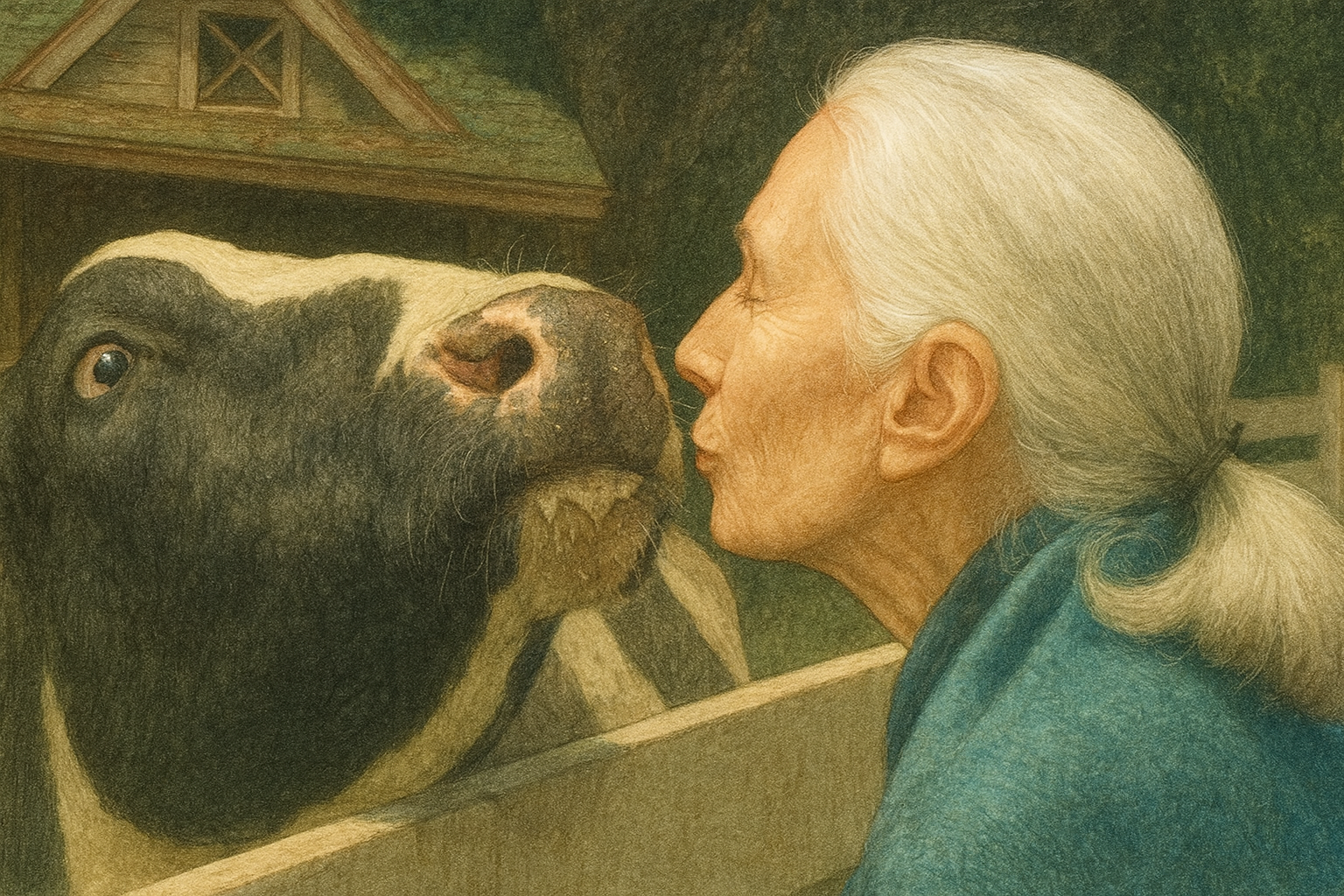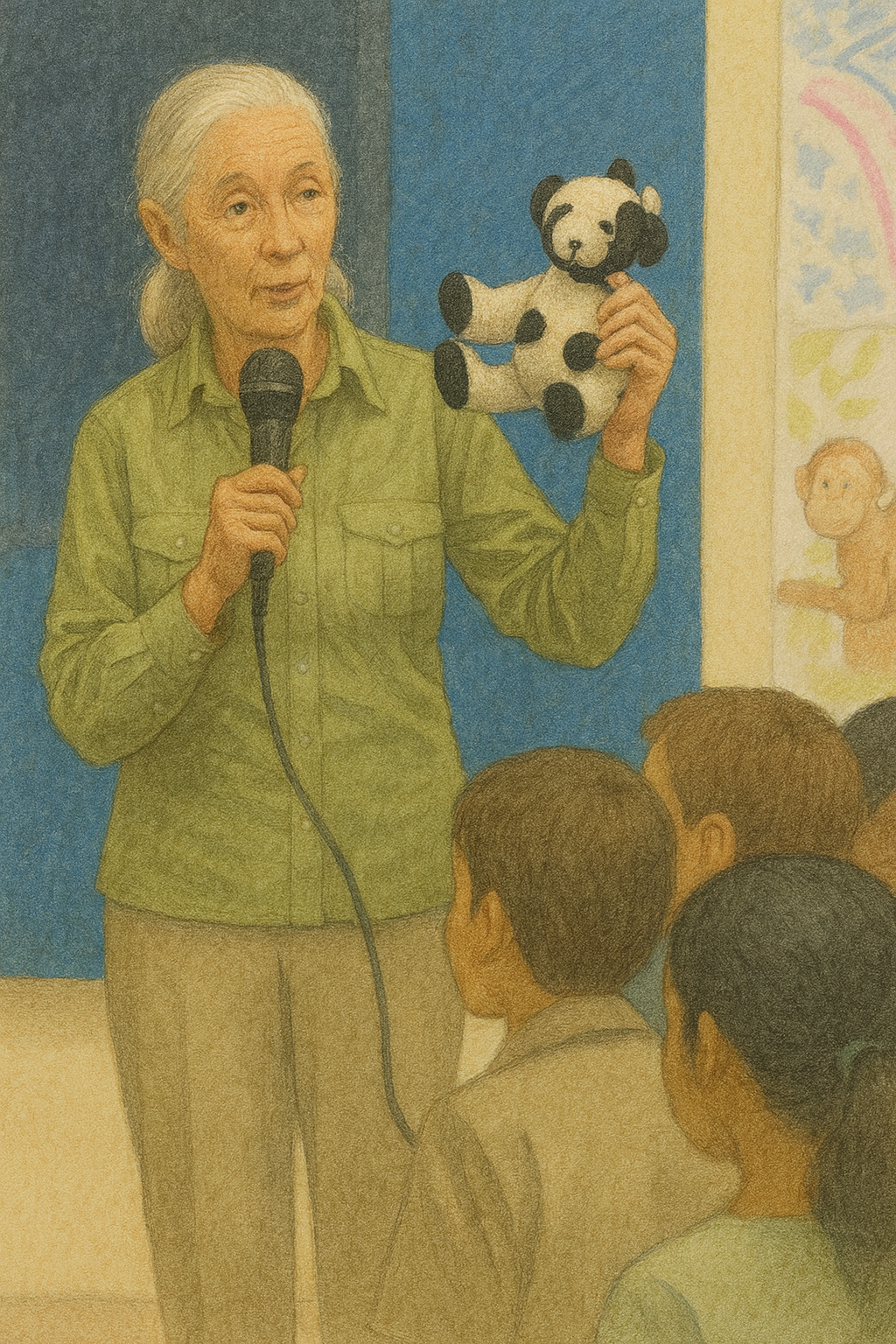Dr. Jane Goodall's Journey From Vegetarian to Vegan
If Dr. Jane Goodall couldn't make the connection overnight, why do we expect everyone else to?
When Dr. Jane Goodall looked at a pork chop fifty years ago and saw “fear, pain, death,” she stopped eating meat instantly. The woman who revolutionized our understanding of animal consciousness had a moment of clarity that changed everything.
But here's what most people don't know: it took her decades more to fully embrace veganism.
This October, as we mark Vegetarian Awareness Month and look ahead to World Vegan Month in November, Dr. Goodall's journey offers something more valuable than a tidy before-and-after story. It offers permission to be human while still moving toward change. And for the millions of vegetarians who find cheese the hardest thing to let go of, her legacy provides both understanding and a gentle challenge.
Because if someone as attuned to animal suffering as Dr. Goodall needed time with this transition, what does that tell us about extending patience to ourselves and others?
From Meat-Free to Dairy-Free: Dr. Goodall's Decades-Long Transition
Dr. Goodall stopped eating meat in the 1960s after that transformative moment with the pork chop. Her connection to animal suffering was immediate and undeniable. Yet even by 2017, when she published her essay “Why I Went Plant-Based,” she was still navigating her relationship with dairy. In a Reddit AMA that same year, her team mentioned that
“she loves cheese too much to be vegan.”
Blunt honesty about how genuinely difficult it can be to make the connection between food and animal suffering when that food is so deeply woven into our daily lives.
Dr. Goodall understood that awareness doesn't automatically translate to action. Making the intellectual connection between dairy products and cow suffering is one thing. Undoing decades of cultural conditioning, biological responses, and emotional attachments is another. If the world's foremost expert on animal consciousness needed time to work through this, it showcases that giving up lifelong cultural teaching and creature comfort can be rather challenging for many.
The important part of Dr. Goodall's story isn't that she struggled. It's that she made the journey anyway. By her final years, she had fully embraced a vegan lifestyle, demonstrating that even our strongest attachments can evolve when we remain committed to our core values.
Understanding Cheese Attachment: Biology and Culture Combined
There's a reason cheese feels different than other animal products. The difficulty isn't imaginary, and it's not a character flaw.
Cheese contains casein, a protein that breaks down during digestion into casomorphins. These compounds bind to the same opioid receptors in your brain that respond to morphine and heroin, triggering dopamine release. This creates a measurable neurological response that researchers have documented in multiple studies.
But the attachment runs deeper than biology. Cheese is tied to comfort, celebration, social connection, and nostalgia. It's the centerpiece of holiday tables, the ingredient that “makes everything better,” the food we reach for when we want to treat ourselves. We have years, sometimes decades, of emotional associations built around cheese.
Understanding what you're working with isn't making excuses. It's being strategic. “Just stop” approaches fail for many people precisely because they ignore these biological and cultural realities. Yet thousands of people move beyond cheese every year using approaches that work with their biology and psychology, not against them.
The shift starts with reframing.
Instead of “I could never give up cheese,” try “Cheese means comfort and connection to me, and I'm exploring how to find those feelings in other ways”.
This acknowledges the genuine attachment while opening the door to change.
Dr. Goodall’s philosophy of patient, incremental change recognized that lasting transformation happens when we honor where we are while still moving toward where we want to be.
From Numbers to Names: Dr. Goodall's Revolution in Seeing Animals
In 1960, when Dr. Goodall began naming chimpanzees instead of numbering them, she violated scientific convention and changed everything.
David Greybeard, Flo, Fifi. Each name recognized an individual personality, not just a research subject. “When you meet chimps you meet individual personalities,” she explained. This simple act became the foundation of modern primatology and the animal personhood movement.
Walk into any dairy facility today, and you'll see the opposite: Cow #487, Cow #2319, Cow #6154. Numbers create the distance that allows exploitation. Yet these females are individuals, just like the chimpanzees Dr. Goodall studied. She knew this, writing later:
Farm animals are far more aware and intelligent than we ever imagined... they are individual beings in their own right.
The science confirms it. Cows form friendships, remember over 50 individual cows and 100+ human faces, and experience emotional contagion. Mothers and calves separated in dairy operations show distress for days or weeks. They literally jump for joy when solving problems or released to pasture. Like chimps, they have distinct personalities: the greeter, the nervous one, the curious one, inseparable best friends.
Every piece of cheese comes from someone specific, not something. The separation trauma Dr. Goodall documented in chimpanzees happens thousands of times daily when calves are removed from mothers within hours of birth. These females are forcibly impregnated repeatedly until their bodies break down around five years old, though they could naturally live twenty.
Dr. Goodall's lasting legacy was changing how humans perceive animal consciousness. The dairy industry survives on invisibility, but Dr. Goodall's approach applies perfectly: make animals visible as individuals. When you see Cow #294 as someone with her own personality and capacity for suffering, the question becomes clearer. This is the same shift Goodall sparked when she looked at chimpanzees and saw people, not research subjects.
Taking Action: What You Do Makes a Difference
“What you do makes a difference, and you have to decide what kind of difference you want to make”.
Dr. Goodall repeated this message throughout her life because she believed deeply in individual power. Her other guiding principle: “Lasting change is a series of compromises. And compromise is all right, as long as your values don't change”.
The key word is “lasting.” Your pace matters less than your direction and your commitment to not turning back. Someone who reduces dairy consumption gradually but permanently creates far more impact than someone who eliminates everything overnight, feels overwhelmed, and reverts to old patterns within weeks. The animals benefit from sustainable change that actually sticks, not temporary perfection.
You've already made a compassionate choice by becoming vegetarian. That decision has spared countless animals. Honor that choice and recognize what it represents about your values. The journey from vegetarian to vegan is about aligning your actions more completely with those values.
Here's how to begin this Vegetarian Awareness Month:
Start with awareness. Learn about cows as individuals or dairy production realities. Information changes perspective. Perspective changes behavior.
Try one dairy-free day weekly. Frame it as exploration, not deprivation. What plant-based meals feel satisfying? What alternatives surprise you?
Experiment with alternatives. Aged nut cheeses, cultured cashew spreads, oat-based cream sauces. Finding options you genuinely enjoy makes all the difference.
Connect your existing compassion. You already said no to meat because you recognized animal suffering. That same heart can extend protection to the mother calling for her calf.
Find community. Online groups, local meetups, one friend making similar changes. The transition is easier when you're not alone.
For those further along: Share your experience, offer support, celebrate progress. Meet people where they are. And always share and demonstrate from a place of abundance.
Some people make this shift quickly. Others move gradually over time. Both approaches reduce suffering. Both honor Dr. Goodall's expanding circle of compassion.
“What matters is beginning. ”
One choice. One conversation. One new piece of information.
This October, as Vegetarian Awareness Month flows into November's World Vegan Month, that progression mirrors the expanding compassion many vegetarians feel. The cows cannot choose, but you can choose not to participate in what happens to them.
Dr. Goodall believed humans, once we truly see and understand, are capable of extraordinary compassion. Based on the choice you've already made to stop eating meat, you're exactly the kind of person she believed in.
Start today. Maybe that means eliminating dairy entirely right now, or maybe it means reducing by half this month and continuing from there. Both are valid starting points if they lead to lasting change. What matters is that you begin and that you build momentum you can sustain. The cows behind your cheese are waiting for someone to see them the way Dr. Goodall taught the world to see chimpanzees: not as resources, but as individuals, as someone. And they need that recognition to translate into sustained action, not fleeting attempts.
Note: For passionate activists reading this: We know gradual reduction can feel frustratingly slow when cows are suffering right now, today. That frustration is valid. Time matters. Each day of dairy production means more calves separated, more mothers grieving, more individuals exploited. But here's the strategic reality we must accept: someone who reduces dairy consumption by 80% over three months and maintains that for life creates far more impact than someone who eliminates 100% for three weeks before burning out and returning to previous consumption patterns. The animals don't benefit from two-week sprints followed by years of the status quo. They benefit from permanent change, even if that change happens incrementally. Our messaging must balance urgency with sustainability if we want lasting results.
Further Reading
The Invention of Dairy: A Story of Survival, Adaptation, and Marketing
Sign Up for Vegan Boot Camp: Get all the guidance and support you need to transition to a compassionate lifestyle.
Follow Us on Social Media: Stay updated on the latest facts about the cruelty of dairy farming, get inspiration, and connect with a community motivated to make a difference. Instagram | Facebook | X | BlueSky
Join our Newsletter Waitlist: sign-up below


